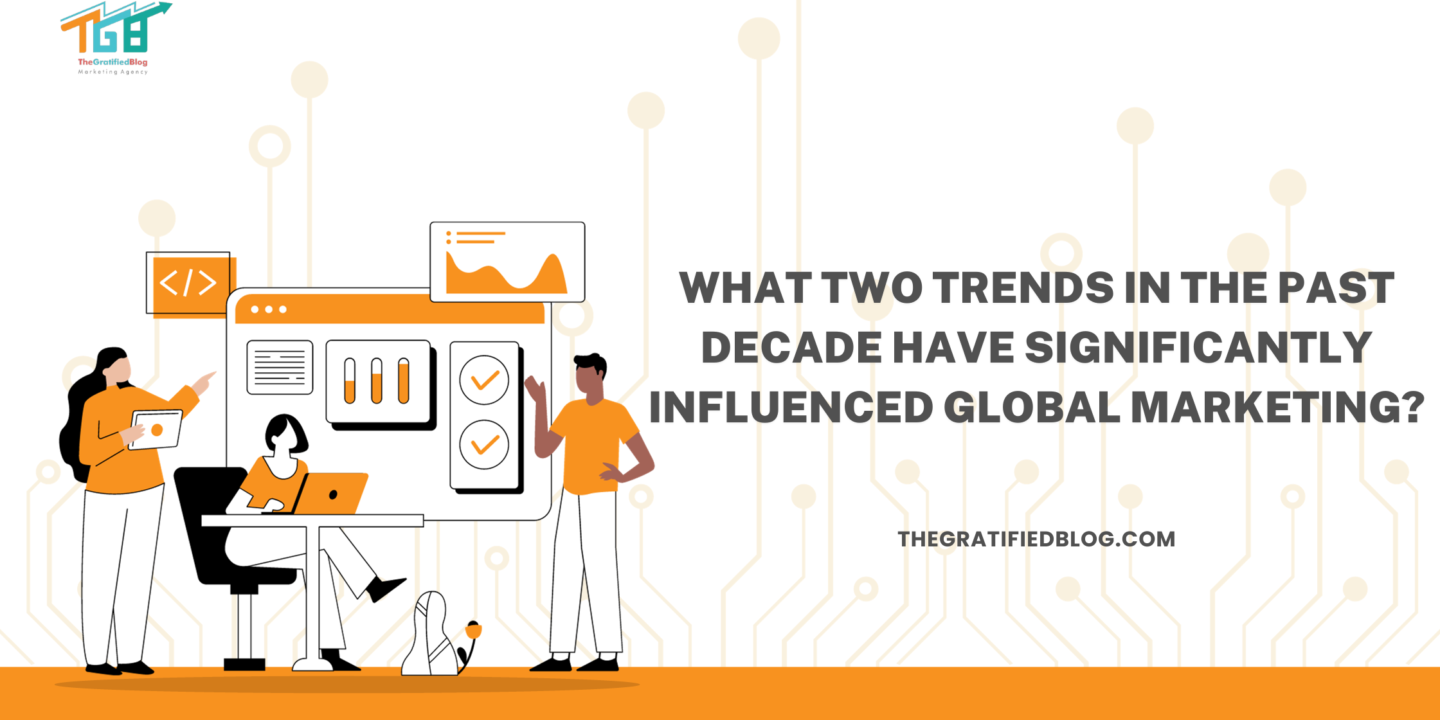
In global marketing, staying attuned to the ever-evolving landscape is not just a matter of choice; it’s a necessity. Over the past decade, two transformative trends have played an integral role in redefining how companies engage with their audiences worldwide. This blog explores the question: “What two trends in the past decade have significantly influenced global marketing?”
By exploring these trends, we aim to uncover their profound impact on marketing, from reshaping strategies to redefining the global marketplace.
So, let’s get started by knowing the trend.
What Two Trends In The Past Decade Have Significantly Influenced Global Marketing?
- Digital Technology, and
- Personalization
These two trends in the past decade have significantly influenced the global market.
Now, let’s dive deeper into both trends.
Digital Technology And Personalization: Twin Pillars Shaping Global Marketing
Digital Technology
Digital Advertising Dominance
The shift from traditional advertising to digital platforms has been remarkable. Marketers now have a vast array of tools to target specific demographics precisely. With the ability to connect with an international audience, businesses can run cost-effective and data-driven campaigns, making measuring and optimizing their efforts easier.
E-commerce Boom
In the past decade, we have witnessed the meteoric rise of e-commerce facilitated by digital technology. With the convenience of online shopping, businesses are no longer limited by geographical boundaries, which has opened up new horizons for global marketing, allowing companies to tap into international markets easily.
Content Is King
Content marketing has become a potent instrument for enterprises to connect with their audience. The rise of digital platforms has enabled brands to produce and disseminate content through diverse channels, helping them build a loyal customer base and establish authority in their niche.
Data-Driven
Decision-Making Digital technology has allowed marketers to collect and analyze vast data. This method, driven by data, empowers businesses to base their decisions on information and insights. By understanding consumer behavior, preferences, and trends, marketers can tailor their strategies for maximum impact, which empowers businesses to optimize their marketing efforts, leading to better ROI.
Social Media Revolution
In the past decade, social media has transformed from a platform for personal connections into a powerhouse for marketing. Digital technology enables businesses to harness the influence of social media by reaching a global audience in real-time.
Platforms like Facebook, Instagram, and Twitter have become essential tools for brand awareness, engagement, and customer feedback. Marketers can now create targeted ad campaigns on these platforms, engaging users based on their interests and online behavior.
Personalization
Customer-Centric Approach
Personalization allows businesses to shift their focus from product-centric to customer-centric marketing. By collecting and analyzing data, brands can understand their customers’ preferences and behaviors, crafting messages and offers that resonate with individual needs and desires.
Enhanced Customer Loyalty
When customers feel that a brand understands them personally, it fosters a sense of loyalty. Personalization aids in forging a connection between the brand and the customer, resulting in repeat business and increased customer lifetime value.
Improved Conversion Rates
Tailoring marketing messages and recommendations based on customer data can significantly boost conversion rates. When consumers see products or services that align with their interests, they are more likely to purchase them.
Behavior-Driven Recommendations
E-commerce platforms and online marketplaces utilize personalization algorithms to provide customers with tailored product recommendations. These algorithms analyze a user’s past purchases, browsing history, and interaction patterns to suggest products or services they are more likely to be interested in, which enhances the shopping experience, increases cross-selling and upselling opportunities, and ultimately boosts business sales.
The Synergy Of Digital Technology And Personalization

The true magic happens when digital technology and personalization come together. Here’s how the combination of these trends can supercharge your global marketing efforts:
- Data-Driven Personalization: Digital technology provides the tools to collect vast amounts of data, and personalization helps businesses make sense of that data. With insights into customer behavior, marketers can deliver highly relevant content, product recommendations, and offers to individual consumers.
- Dynamic Advertising: Through digital technology, marketers can adjust their advertising campaigns dynamically in real-time. As an illustration, if a customer leaves their shopping cart behind, an automated personalized email can be sent, encouraging them to complete the purchase. This dynamic approach significantly improves the chances of conversion.
- Global Reach with a Local Touch: With digital technology, businesses can expand their reach globally, while personalization allows them to maintain a local touch. Tailoring marketing efforts to cater to different regions’ unique preferences and cultural nuances ensures a deeper connection with international audiences.
Challenges Present In The Digital Technology Era And Personalization
While these trends offer immense potential for global marketing, they also present some challenges; here are some of them:
- Data Privacy Concerns: Personalization relies heavily on collecting and analyzing customer data; data privacy and security concerns have grown. Businesses must navigate the delicate balance between personalization and respecting user privacy.
- Content Saturation: Consumers are exposed to overwhelming content daily in the digital age. Standing out in a crowded digital landscape requires creative and innovative strategies.
- Technological Adaptation: Keeping up with the latest digital technologies can be daunting for some businesses. Staying competitive in global marketing demands continuous learning and adaptation.
Conclusion
Now that we understand “What Two Trends In The Past Decade Have Significantly Influenced Global Marketing?” it’s time to harness the power of these trends. Integrating these trends into our marketing strategies can unlock new opportunities, enhance customer engagement, and drive growth.If you still have any questions related to the blog, then feel free to leave your questions in the comments section. We will be happy to answer you.
Thanks for reading 🙂








No Comments